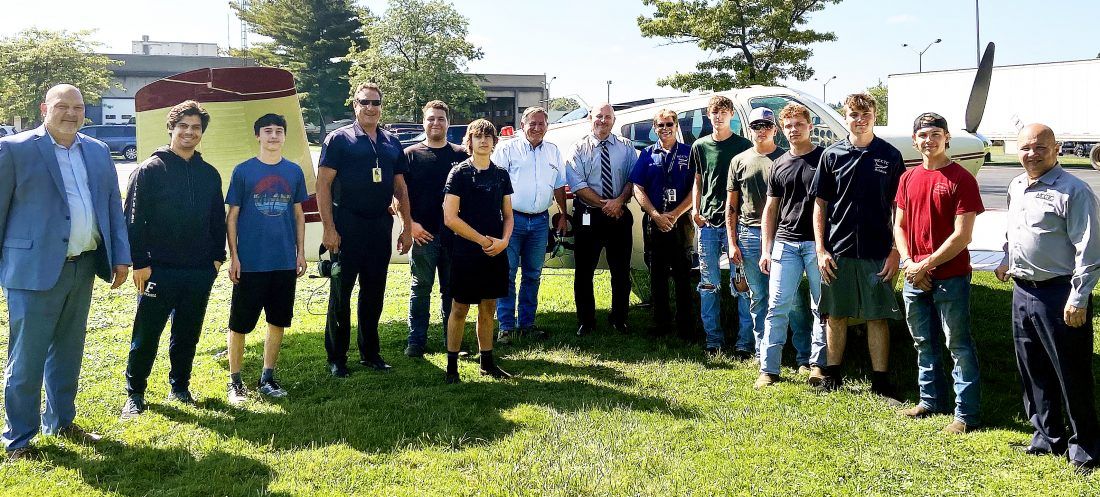Dave Williams, a Youngstown, Ohio-area owner pilot of a vintage Beechcraft V-tail Bonanza, has confidently placed the care and maintenance of his aircraft in the hands of a group of high school students. The Mahoning Country Career and Technical Center (MCCTC) in Canfield, Ohio, near Youngstown, has operated vocational programs since 1972. Michael Stanko, owner and operator of Gemco Aviation at Youngstown Elser Metro Airport (4G4), where Williams’s Bonanza has been serviced over the past several months, is also president of the MCCTC school board. He said, “Our students will be able to perform various inspections on this aircraft, as required by the FAA, and will be able to simulate a multitude of operational functions of the aircraft.” Stanko added, “MCCTC holds a special place in my heart as I was fortunate enough to be in the first graduating class of the aviation program in 1974.”
Students enrolled in the FAA-certified A&P program at MCCTC can receive their A&P certificate in two years for a cost of around $600, contrasting with around $3,000 elsewhere, according to Scott Rowe, aviation instructor at the school. The high school also has cooperative programs with Parks College in St. Louis, Kent State University in Ohio and Eastern New Mexico University in Roswell. Graduates of the MCCTC program receive credits toward college degrees in aviation for their high school training. MCCTC also offers adult programs in aviation maintenance.




































This program is needed!
I recently had an A/I retire after 35 years. Tried to find a replacement—called 17 airports—no mechanics to be found. What I DID FIND is that almost half the A&Ps surveyed were over age 70!
I should have seen it coming—we were getting calls from 100 miles away for annuals. Most rural airports had not taken on a new customer in 2-3 years!
Checked with A&P schools—nearly all graduates had a job offer on graduation.
I got lucky—a former employee that left us 30 years ago to work for Lear—then for BEECH in Wichita retired and wanted to move back—and he asked US!
We need Canadian style ability to work on your not for hire airplane—homebuilt, kit built, or factory built. If sold, it can be taken back into commercial use with an ordinary inspection.
FAA has been “working on it” for YEARS (along with other pilot and maintenance reforms) with no changes. Makes you wonder how we ever managed to be the leader of the free world in Aerospace—but then, more than most Americans—we have seen government (in the form of the FAA) at its WORST—over regulation—hidebound procedures—“paralysis by analysis”—and lack of urgency and clear direction.
I have a 1927 and a 1951 book of FAR’s—they address the same regulation (using much of the same language in 17 pages and 64 pages—how many FEET OF SHELVES do the current FARS take up?
Jim, Sadly, the old joke, “we’re not happy until you’re not happy”, does apply all too well to the FAA. Your description of “hidebound, etc, is far too apt. It, way too often, seems as if their goal is to completely prevent aviation thereby making aviation perfectly safe with a zero accident rate. Can you imagine the results if the NHTA adopted the FAA’s approach dealing with roads? Ouch!
The 121 carrier I worked for towards the end of my career had a really good relationship with the FAA. The 125 operator I was with for 5 years after that lucked out with the FAA folks assigned. They were sensible folks and we tried very hard to do everything to 121 standards making it much easier to succeed with the FAA in the murky 125 world.
Funny how, with the current FAA being extremely short handed, they won’t think outside the box to get people. Several guys locally, ones that I flew with in the military, are with, retiring from, or retired from the busy local FAA office. They have all been trying to get me to come on board with them. On the surface, my “resume” looks good: 23 years military all Military Airlift Command, 20+ years Part 121 mainly -747 airfreight world wide, 20K+ hours mostly in command, lengthy Instructor and Flight Examiner time in -141’s, and 50 years experience in the ground side of freight operations management / command and control. Hmmm… not good enough for the FAA today. They want me to, on my own nickel, get my MEI, CFI, CFII, ad nauseum, before they will talk to me. Talk about “hide bound!